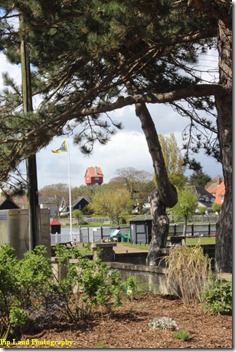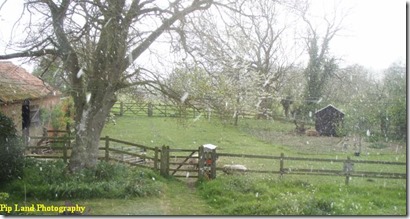Snow, hail, thunderstorms and a biting cold wind – not what one expects in North Suffolk at the end of April. Thankfully, we were staying in a delightful B&B and were looked after in grand style by Annie and Bob Jellicoe at Hall Farm, Wenhaston. From there we visited Southwold, Leiston, Aldeburgh, Thorpeness, Dunwich and Walberswick and the lovely countryside and coastline in that area. (Above: snow falling at Hall Farm paddock – click on this to see more photos)
We had spent two days preparing David’s boat, Edna May, for her visit to Boulter Marine at Horning where she had her top cleaned. For me, the most enduring memory of those few days was how cold it was. So it was wonderful to walk into the kitchen at Hall Farm and luxuriate in the warmth emitting from their large Aga. From there we were ushered up the steps to where we could step down into our own little annex (in the 19th century extension) with a lovely bedroom and a private shower room. Each provided us with views of the paddock where an elderly Southdown ewe was spending a restful retirement in the company of two two yearlings and a flock of hens.
What fascinated me most was the large wooden beam at the top of the stairs which formed part of the original late 16th century farmhouse. David, however, would often stop on the stairs and study the maritime pictures hung on the walls. So it wasn’t surprising later to learn that Bob not only worked as a volunteer at Southwold Museum but also at Southwold Sailors’ Reading Room where the town’s maritime history is celebrated.
On that first evening we were happy to eat at The Star nearby and return to our cosy room to read our books. That meal was soon overshadowed by the excellent breakfast served from that warm Aga with laughter and good conversation. That conversation began, of course, on the topic of the weather – for we had awoken to the sight of snow falling. It didn’t last long and disappeared as soon as it hit the ground, but it was a warning that the cold weather was to continue.
One of the specialities of Hall Farm was Bob’s homemade bread and he made a white loaf for me as I have problems with wholemeal bread due to my many food intolerances, whilst Annie produced some deliciously light and fluffy scrambled egg for me even though she had never used soya milk for that before.
We spent the morning in Southwold and paid a short visit to the Amber shop and museum. It was fascinating to see examples of amber still in its natural state, and then how some had been skilfully carved by artisans in different cultures. From there we took a stroll down Southwold’s pier and its attractions including the House of Games, Tim Hunkin’s whacky and weird machines in the Under the Pier Show, and took time to watch the Water Clock. Tim Hunkin and Will Jackson created this in just three weeks in 1998 as a cheeky way of illustrating how water can be recycled. They left it to the imagination of their amused audiences as to what happened to some of the output! (Click on the photo above to see what I mean!)
The pier provides an excellent viewing platform for Southwold, from its multi-coloured beach huts to its lighthouse. The latter is still in operation almost 130 years after it was built by Trinity House, the charity which continues to monitor and control it. We didn’t join one of the tours but instead visited the harbour, had a drink at the Harbour Inn and then went on a short tour of some of the fascinating countryside further south.
Our route to Dunwich took us past Westleton Heath and some towering hedges of golden gorse. We briefly considered having our evening meal at The Ship, but at 5.45pm the evening menu still wasn’t available. When one was finally produced it included ham in a vegetarian meal! We decided to look elsewhere. Our meanderings this time took us through Dunwich Forest which is part of the Suffolk Coasts and Heaths Area of Outstanding Natural Beauty.
As the White Hart at Blythburgh was on Annie and Bob’s list of good hostelries we stopped there and once inside headed for the seats near the cheery, crackling log fire. The staff happily helped us find food we could eat: a very tasty gnocci and mozarella with red pepper pesto for David, and beer-battered haddock for me. Once well supped it was back to the comforts of Hall Farm.
Next morning we visited Leiston and had just got inside the Long Shop Museum when hail stones began pounding on the roof. David had especially wanted to see the Long Shop where flow line assembly was introduced by Richard Garrett III in the 1850s to produce portable steam engines.
David was amazed at the engineering, the innovation, the diversity and quality of the products manufactured there from 1778 until 1980. “They made all sorts of things – anything anybody wanted they made it. It was totally fascinating and it was a wonderful visit,” he said.
It was one of the volunteers at the museum who recommended the vegetarian cafe, Simply Delicious, to us. David was in veggie heaven as there was such a wonderful choice of dishes. Even I could have some of the salads as well as a delicious slice of vegan carrot cake. We both ate too much and felt very spoilt!
We managed to miss the hail and thunder storms on a day when it was better to watch the weather from the shelter of the car. We motored to Thorpeness where I marvelled at the fantasy holiday village created by Stuart Ogilvie in 1910. The mock Tudor houses are very well maintained as is the “House in the Clouds”. (below)
We continued south to Aldeburgh and were pleased to find that the town’s museum in the 16th century Moot Hall was open that afternoon. It was fascinating to learn that the town council has met in the upper room since the Moot Hall was built. The town can also boast having Britain’s first woman mayor as Dr Elizabeth Garrett Anderson held that position between 1908 and 1910. In December the town will celebrate the 100th anniversary of her death. I couldn’t help thinking that her mother’s life should be celebrated too.
For what a family of girls Louise Garrett had! Her second daughter, Elizabeth, against all the opposition from men, became the first woman in Britain to qualify as a surgeon and physician. Another daughter, Milicent, joined the suffragist movement when she was 19-years-old and was a co-founder of Newnham College in 1875. In April 2017 Dame Millicent Garrett Fawcett became the first woman to be honoured with a statue in Parliament Square.
Her sister, Agnes, joined her cousin, Rhoda Garrett, in undertaking an architectural apprenticeship in 1871 and four years later they set up set up what has been described by Helena Wojtczak as the first all-female design and decorating company, and won many high-profile commissions for public buildings and residences. Rhoda was the daughter of an impoverished vicar who refused to accept that she was destined to be a lowly governess.
The Garrett family’s legacy in Aldeburgh is the world-famous music centre The Maltings. This was originally a warehouse and then a brewery set up by Elizabeth Garrett Anderson’s father, Newsom, the brother of Richard Garrett III of Leiston.
The Moot Hall provided us with an opportunity to understand how the thriving town and harbour at Dunwich was lost to the sea in medieval times leading to greater prosperity for Aldeburgh (there is also a museum at Dunwich). We certainly enjoyed our visit to Aldeburgh Museum – and afterwards drove past the yacht club to see the Martello Tower. That unmade road provided us with a good place to park and watch the sea for a while from the comfort of the car.
After our large meal at lunchtime we decided that two “starters” at the Harbour Inn at Southwold should be sufficient. I was very impressed that, as soon as we w alked in, the staff remembered that I had discussed food intolerances with them. I had a delicious plate of smoked sardines while David tucked in with relish to baked Camembert.
alked in, the staff remembered that I had discussed food intolerances with them. I had a delicious plate of smoked sardines while David tucked in with relish to baked Camembert.
On our journeys to and from Southwold I always watched for the bluebell wood near the junction of the A1095 with the A12. The most distinctive feature of the landscape at that time was the brilliant yellow of the rape fields, but that was offset by the gentle green of the swathes of umbellifer along many of the verges and also beside the promenades in Southwold. (On the way to Wenhaston we saw the magnificent displays of cowslips along the verges of the ring road at Norwich.)
The following day we visited the small but very interesting Southwold Museum. Bob showed us the even smaller archives and cataloguing room. That made me realise how fortunate we were at Hawes to have such a large, well stocked research room. I often felt we were walking through history in Southwold and the other villages due to the many centuries-old houses from those of high status to lowly fishermen’s cottages. Museums like those in Southwold and Aldeburgh helped us to understand that history.
On leaving Southwold Museum we gave the Adnams cafe a miss as two days before I had had a dreadful mug of coffee there. It was so bad that I left most of it – which was not easy to do when it cost so much. Instead we went to Le Roc. The coffee was great and they even had an amazingly good parsnip and honey cake which I could eat. Afterwards we went back to The White Hart at Blythburgh for another superb meal.
Our food experience had been further enriched by Bob’s bread-making. He introduced us to a medieval peasant’s blend which contained broad bean and pea flour. It was gorgeous. I must have a go at making that bread.
We were sad to say goodbye to Bob and Annie for they had made us so welcome. We had shared a lot of information and laughs – but it was time to collect Edna May. Maybe we should plan another visit as we didn’t go to see the fascinating medieval paintings in Wenhaston and Southwold churches.
We returned via Bungay for on the way to Wenhaston we had found a special place to eat: the Earsham Street Cafe. We had been amazed that it was so busy on a Monday that folks were being turned away at midday. So David had booked a table for our return visit.
Thanks to the team at Boulter Marine Edna May sparkled, but we were very aware that, on our next visit to Thurne, we would have a lot of painting to do to complete her transformation. I only hope that the weather is a lot warmer!
